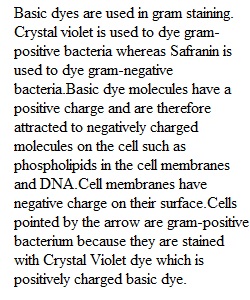


Q Critical Thinking 1 25pnts NAMES: All questions are worth one point unless otherwise stated. Please use short answer format when answering questions. The organism in the gram stain pictured is from an active infection. The larger stained cells are from the human tissue and the smaller darker stained cells are the infectious agent. The larger looking cells are in pink and the smaller cells are in purple (arrow pointing to smaller cells, infectious agent unknown organism). IMAGE A (1000x) 1. Image A is from a gram stain. (3 points) What types of dyes are used in the gram stain, basic or acidic? b. What is the charge on the dye molecules? c. What is the charge on the cell wall/ cell membrane that bind to the dye molecules?2. Refer to Image A. (3 points) a. Define if the gram stain reaction shown in the image (the cells pointed to by the arrow) are gram positive or gram negative? b. Describe the cell shape and arrangement of the unknown organism (the cells pointed to by the arrow) to the best of your ability.
View Related Questions